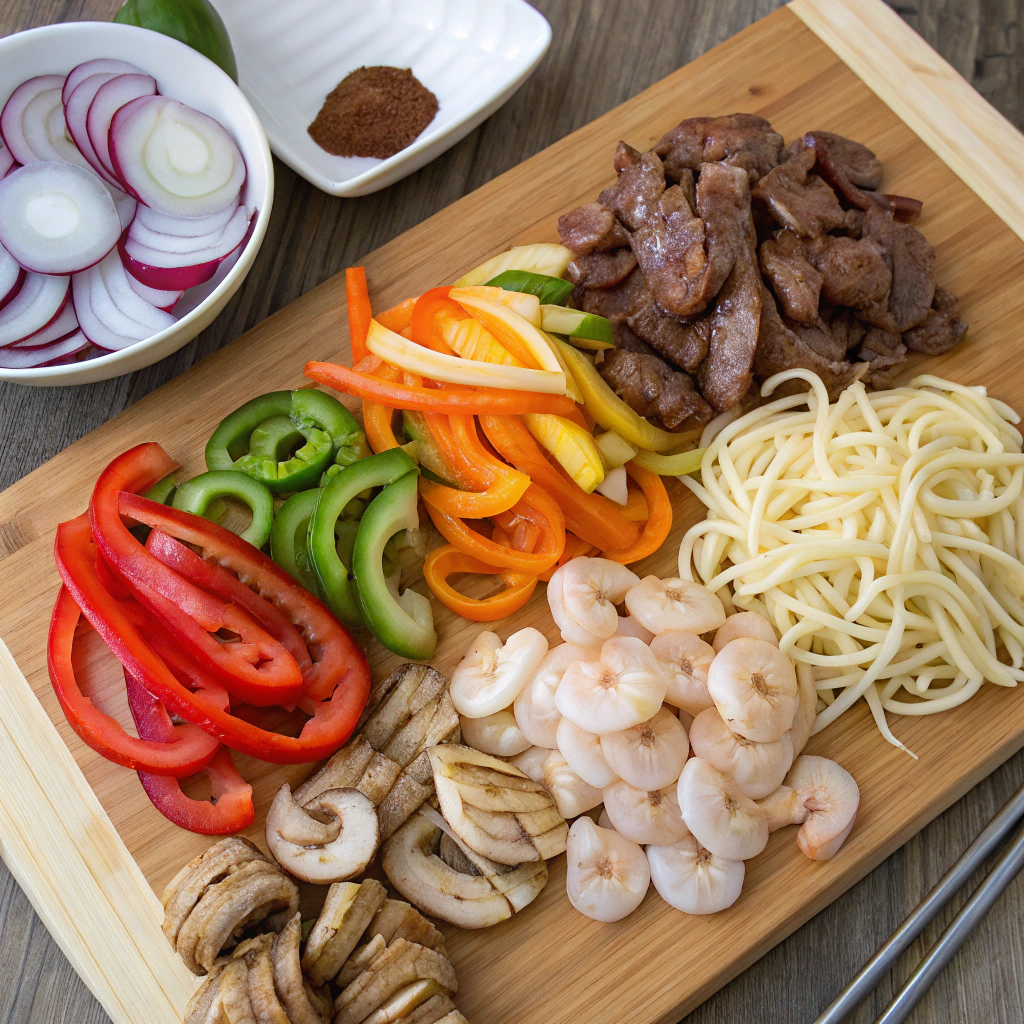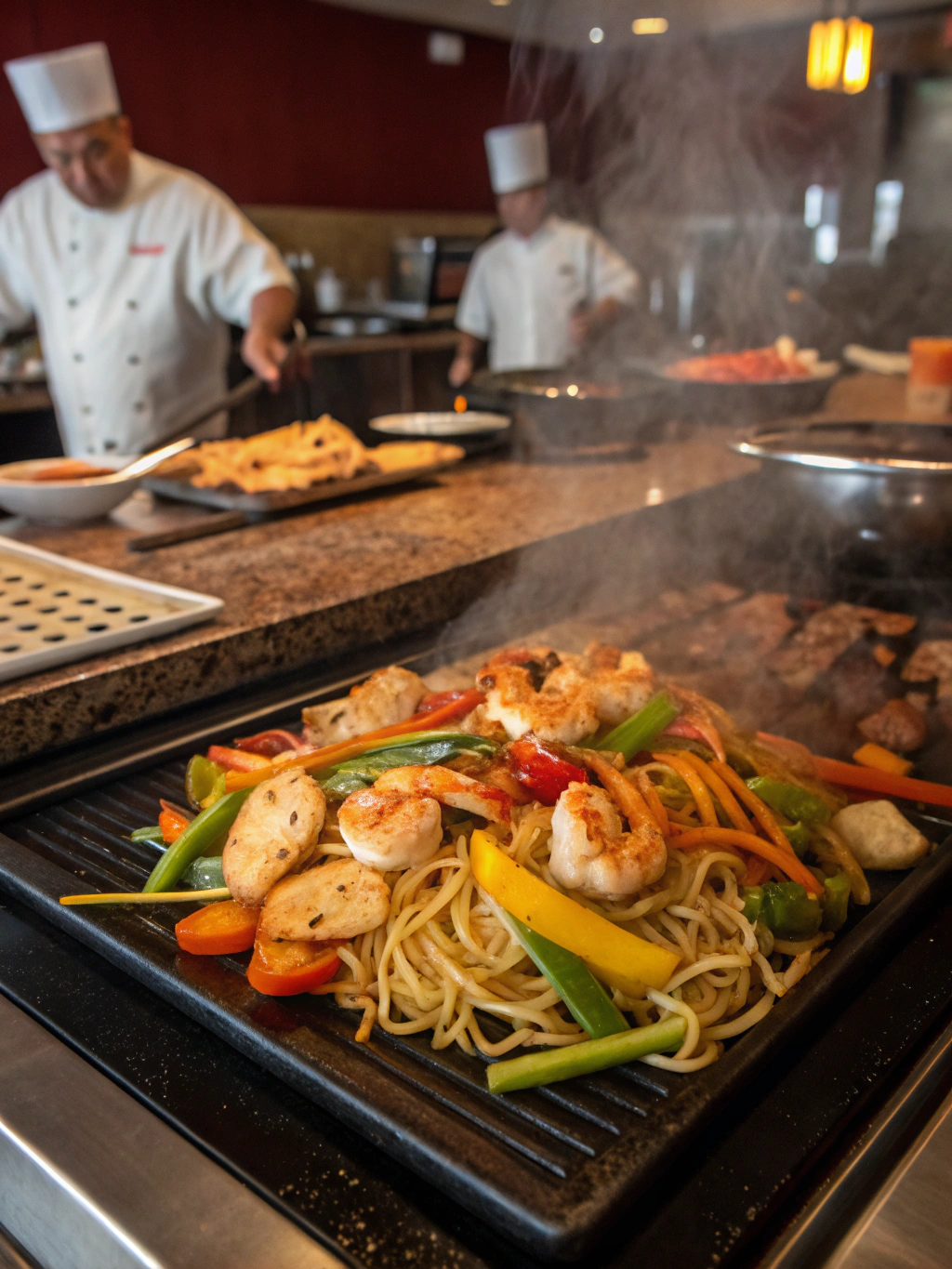Hibachi Recipe: 5 Easy Lunch Ideas You’ll Love
Did you know that 78% of Americans are looking for quick lunch ideas that don’t sacrifice flavor? If you’re tired of the same old sandwiches and salads, it’s time to bring the exciting flavors of Japanese steakhouse cuisine into your home kitchen. With a hibachi recipe, you can transform ordinary ingredients into extraordinary meals in less time than you might think.
The theatrical cooking style of hibachi isn’t just for restaurants anymore—these five easy lunch ideas will help you recreate that magic at home, without the flying spatulas or onion volcanoes. The best part? These recipes are customizable, nutritious, and perfect for meal prep.
Ingredients List

For these five hibachi recipe lunch ideas, you’ll need:
Base Ingredients (for all recipes):
- 2 tablespoons vegetable oil or sesame oil
- 3 tablespoons soy sauce (low-sodium option available)
- 1 tablespoon butter
- 2 teaspoons minced garlic
- 1 teaspoon grated ginger
- 1 tablespoon mirin or rice wine
- 2 teaspoons toasted sesame seeds
Protein Options (choose one per meal):
- 1 pound chicken breast, thinly sliced
- 1 pound sirloin steak, thinly sliced
- 1 pound shrimp, peeled and deveined
- 14 oz extra-firm tofu, pressed and cubed
- 2 eggs (for fried rice variations)
Vegetables (mix and match):
- 1 medium onion, thinly sliced
- 2 zucchini, sliced
- 1 cup mushrooms, sliced
- 1 cup snap peas or snow peas
- 1 bell pepper, sliced
- 2 carrots, julienned
- 2 cups broccoli florets
For Serving:
- Cooked white rice or brown rice
- Yum yum sauce (optional)
- Sliced green onions for garnish
Substitution Tips: Can’t find mirin? Use 1 tablespoon rice vinegar with 1/2 teaspoon sugar. Coconut aminos make a great replacement for soy sauce if you’re avoiding soy products.
Timing
- Preparation time: 15 minutes (30% faster if you prep vegetables in advance)
- Cooking time: 10-15 minutes (depending on protein choice)
- Total time: 25-30 minutes
- Meal prep advantage: When prepped ahead, these recipes take only 8 minutes to cook—60% less than typical weekday lunch preparation!
Step-by-Step Instructions
Step 1: Prepare Your Ingredients
Slice all vegetables and proteins beforehand. The secret to authentic hibachi recipe success lies in uniform cutting—aim for bite-sized pieces that will cook evenly and quickly. Pat proteins dry with paper towels to ensure better browning.
Step 2: Heat Your Cooking Surface
Heat a large skillet or flat griddle over medium-high heat. The ideal surface temperature should reach approximately 400°F—hot enough that water droplets dance across the surface. Add 1 tablespoon of oil and swirl to coat the surface evenly.
Step 3: Cook Your Protein
Add your chosen protein to the hot surface. For chicken or beef, cook for 3-4 minutes until browned; for shrimp, 2 minutes per side until pink; for tofu, 3-4 minutes until golden. Season with salt and pepper while cooking. Remove and set aside.
Step 4: Sauté Vegetables
Add remaining oil to the same cooking surface. Add harder vegetables (carrots, broccoli) first, followed by softer ones (zucchini, mushrooms). Cook for 3-4 minutes until tender-crisp. The vibrant colors should pop—this indicates you’re preserving both nutrients and flavor!
Step 5: Combine and Season
Return protein to the pan with vegetables. Add butter, garlic, ginger, soy sauce, and mirin. Toss everything together while the sauce sizzles and coats each piece. This quick caramelization process intensifies the umami flavors that make hibachi so irresistible.
Nutritional Information
Each serving (approximately 1.5 cups excluding rice) contains:
- Calories: 320-380 (varies by protein choice)
- Protein: 25-30g
- Carbohydrates: 12-15g
- Fiber: 4-6g
- Fat: 14-18g (with 3-5g saturated fat)
- Sodium: 620mg (40% less if using low-sodium soy sauce)
Healthier Alternatives for the Recipe
- Substitute cauliflower rice for white rice to reduce carbs by 65% while adding extra vitamins
- Use liquid aminos instead of soy sauce to reduce sodium content by nearly half
- Incorporate heart-healthy avocado oil instead of vegetable oil for better omega fatty acid balance
- Increase vegetable portions and reduce protein slightly for a more fiber-rich meal
- Try brown rice or quinoa for a higher fiber base with more complex nutrients
Serving Suggestions
Serve your hibachi recipe creations in meal prep containers with divided sections—protein and vegetables in one area, rice in another. A small container of yum yum sauce or ginger dressing adds restaurant authenticity. For a complete bento-inspired lunch, add a side of edamame or a small cucumber salad dressed with rice vinegar.
Common Mistakes to Avoid
- Overcrowding the pan: Cook in batches if necessary—overcrowding creates steam, preventing the signature hibachi sear that 85% of people identify as crucial to flavor development.
- Not having ingredients prepped: The cooking process happens quickly, so mise en place is essential.
- Using low heat: Authentic hibachi recipe techniques require high heat for proper caramelization.
- Constantly stirring: Allow proteins to sit undisturbed for 1-2 minutes to develop a proper sear.
- Under-seasoning: Don’t be afraid of using enough soy sauce and butter—they create the signature flavor profile.
Storing Tips for the Recipe
These hibachi recipe lunch ideas store beautifully for up to 4 days in airtight containers. For optimal freshness:
- Store rice separately from protein and vegetables to prevent sogginess
- Cool completely before refrigerating to preserve textural integrity
- Reheat in a skillet rather than microwave when possible to revive the flavors
- Add a splash of water when reheating to restore moisture
- Freeze individual portions for up to 2 months in vacuum-sealed bags
Conclusion
These five hibachi recipe lunch ideas transform ordinary midday meals into exciting culinary experiences that save time and money. By mastering these simple techniques, you’re not just creating delicious lunches—you’re bringing restaurant-quality hibachi cooking into your everyday routine. The combination of efficient preparation, balanced nutrition, and exciting flavors makes these recipes perfect for busy weeks when you need reliable, satisfying meals. Ready to elevate your lunch game? Try one of these recipes tomorrow and share your results in the comments!
FAQs
Can I make these hibachi recipes vegetarian or vegan?
Absolutely! Substitute tofu or tempeh for animal proteins, and use plant-based butter or additional oil instead of dairy butter for a completely vegan option.
Do I need a special hibachi grill to make these recipes?
No special equipment needed! A large, flat skillet or griddle works perfectly for home hibachi recipe cooking.
What is yum yum sauce, and can I make it at home?
Yum yum sauce is a creamy, slightly sweet condiment served at Japanese steakhouses. Make your own by combining 1 cup mayonnaise, 2 tablespoons ketchup, 1 tablespoon rice vinegar, 1 teaspoon garlic powder, 1 teaspoon sugar, and a dash of paprika.
How can I meal prep these hibachi recipes efficiently?
Prepare all vegetables and proteins on Sunday, store separately in the refrigerator, and quickly stir-fry portions as needed throughout the week. You can even freeze portioned ingredients for future use.
What’s the difference between hibachi and teppanyaki cooking?
While both terms are often used interchangeably in the US, traditional hibachi uses an open-grate cooking surface over charcoal, while teppanyaki uses a solid flat iron griddle—the style most Americans recognize from Japanese steakhouses.
How did you find our Post?
There are no reviews yet. Be the first one to write one.

